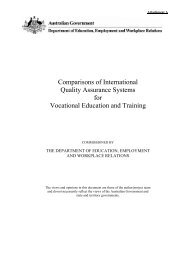2011 Strategic Roadmap for Australian Research Infrastructure
2011 Strategic Roadmap for Australian Research Infrastructure
2011 Strategic Roadmap for Australian Research Infrastructure
You also want an ePaper? Increase the reach of your titles
YUMPU automatically turns print PDFs into web optimized ePapers that Google loves.
intersect with complementary environmental data sets. This systems approach<br />
should lead to a greater ability to assess environmental impacts from population<br />
expansion, and predict the effects of natural hazards on humans and<br />
infrastructure.<br />
The investments under the Sustainable Energy Future Capability area (Biofuels<br />
and Fusion) have been limited and the EWG supports additional investment, not<br />
only in the area of energy sources, but also research infrastructure to support<br />
energy systems research. Investment in research infrastructure to support new<br />
system-level energy research will be critical to decarbonise our electricity grid and<br />
attract the much needed massive investments to urgently trans<strong>for</strong>m electricity<br />
grid infrastructure.<br />
1.C.1<br />
What are your views on the existing funded facilities, including their ability<br />
to meet the current and future research needs?<br />
Section D: e<strong>Research</strong> infrastructure needs<br />
The EWG considers that data integration, transmission, storage and access to<br />
simulations and models are an urgent priority.<br />
While the existing facilities are making great progress in managing the<br />
observational data streams, there is an urgent need to accelerate investment in<br />
the necessary storage and access infrastructure and to ensure that all the data is<br />
accessible, discoverable, interoperable and gathered and stored at the finest scale<br />
possible.<br />
The <strong>Australian</strong> National Data Service (ANDS), <strong>Research</strong> Data Storage<br />
<strong>Infrastructure</strong> (RDSI) project and the National <strong>Research</strong> Network (NRN) projects<br />
are contributing to improving these aspects, but more work is required.<br />
Many of the Capability areas identified are reliant on access to supercomputing<br />
capabilities to process the large volumes of data received through remote sensing<br />
and ’omics based approaches, to undertake complex modelling and projection of<br />
the climate system and the natural environment. The continued development of<br />
the National Computational <strong>Infrastructure</strong> (NCI) is there<strong>for</strong>e vitally important.<br />
For example, without urgent investment in the NCI storage capability, the next<br />
Intergovernmental Panel on Climate Change (IPCC) Assessment will be complete<br />
be<strong>for</strong>e <strong>Australian</strong> scientists have access to this important international petabyte<br />
size data set that is critical to understanding Australia’s future climate.<br />
As the sophistication and time-space resolution of earth system modelling is<br />
extended it is reasonable to assume that Exabyte capability will be necessary to<br />
support simulation experiments within the next five to ten years.<br />
1.D.1<br />
What are your views on the e<strong>Research</strong> infrastructure identified, including<br />
their relative priority and ability to support the current and future<br />
e<strong>Research</strong> infrastructure needs?<br />
16
















